Scotland
Monday: The Journey North
Waking to the harsh chirping of my alarm at half five in the morning, I reminded myself why on earth I would want to be up so early and crawled out of bed. Way back in the eighth grade, when I was doing the geography bee and asked where I would go out of anywhere in the world, I answered, "Hm, probably Scotland." Today, I would scratch that off my To Do list.
I swung down to London on the ole 797, then caught the bus that would take me all the way up to Glasgow. The ride actually was not that bad, just a little cramped and reminiscent of long family trips. While I spent most of the time reading through The Life of Pi (pretty good, 6.8 overall, lots of pseudo-philosophical and pseudo-theological ramblings with plenty of humorous anecdotes and very clever lines swirled into it), I also stared out the window, gazing at the North of England slipping by. We passed by Liverpool and Cheshire, and I smiled to think that somewhere out there would've been Star's Manor. It rained often, but sometimes the clouds would thin out to the point you could see the disc of the sun floating white amid the gray. It's fun to watch the sun through the clouds, filling you with a giddy sense that you probably shouldn't, but it's so amazing you can't look away, like peeking into the eyes of a pretty girl.
Agh, too poetic! That's what happens from reading literary books all day.
Anyway, I ate tuna sandwiches I had packed for lunch and soon enough we crossed the Scottish border. Just after the big welcome sign was a massive factory outlet mall. That's the Scots, I suppose. Scotland looked much different from England, with more yellowed grasses, rocky crags, and seemingly infinite sheep with a few cows thrown in for good measure. There were lots of lambs, too, each more adorable than the last.
The bus got into Glasgow early (I never imagined a bus arriving early; on fire, maybe, but not early), and I met up with Gordon, with whom I'd be staying for the week. We knew each other from a couple of brief meetings when he was visiting his former flatmate from Zimbabwe now at Hatfield. What a crazy link. I was eager to stretch my legs after the bus ride, so Gordon showed me around a little.
First we walked past the city cinema, which Gordon said was the tallest cinema in the world. What a strange claim to fame, but cool enough.

Afterward we went through one of the shopping districts, which had a statue of Dewar, the first Scottish first minister.
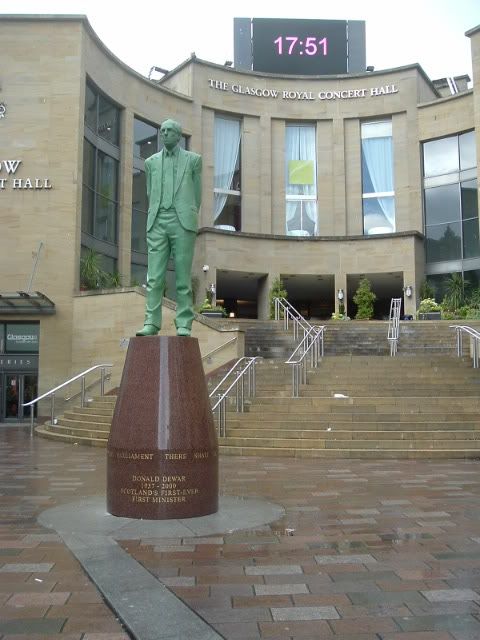
Then we walked down pedestrianized Buchanan Street, where everybody was talking Scottish, and I couldn't understand a word. As nearly as I can figure, the Scots somehow ended up with a mixture of guttural German, nasal French, and weird pronunciations from northern England. Despite it still being technically English, I think I had an easier time understanding Italian.
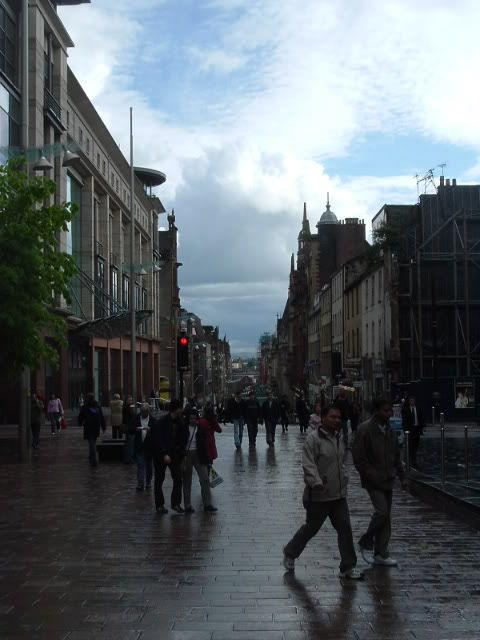
We hopped down the street to George Square, a plaza right next to the City Chambers and a tourism office where I could mooch a map.

Scottish architecture is, in my ever-so-humble opinion, pretty awesome. It only ranges back a few hundred years, creating a mixture of modern and, my favorite, Victorian. Strangely, everything is very gray and depressing, but Gordon assured me that it's just to match the sky.
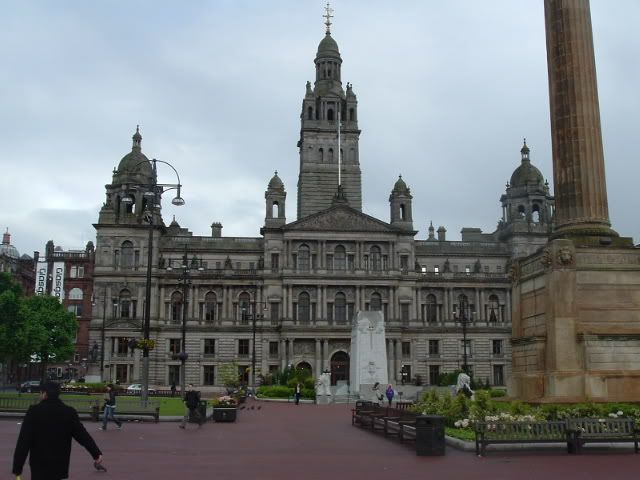
George Square was jam-packed with statues of famous Scots, like Sir Walter Scott, the writer and somewhat adventurer.
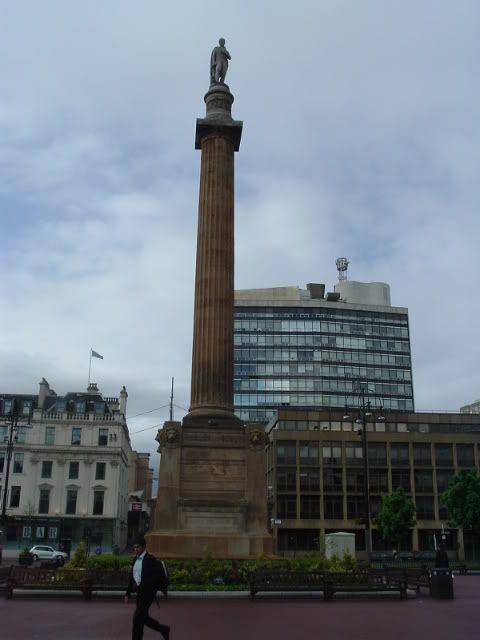
Nearby was Robert Burns, poetical dude.
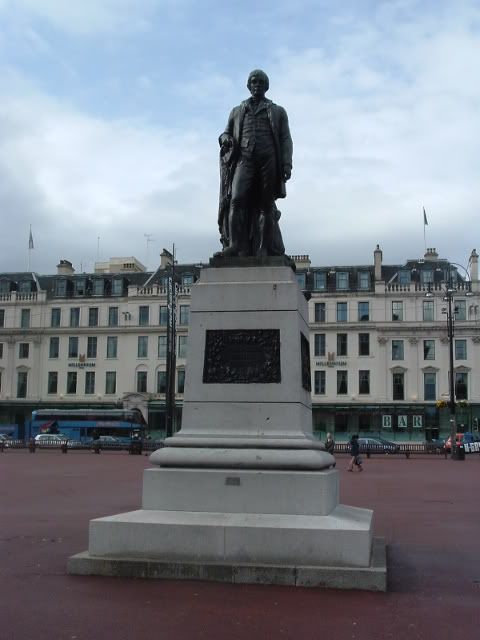
And James Watt, bigtime inventor and scientician.

We left the square and walked toward the train station, passing a statue of Wellington. Gordon said it was customary that people would deface the monument by putting a traffic cone on Wellington's head. Sadly, the police were keeping an eye out and Wellington was hatless while I was there.
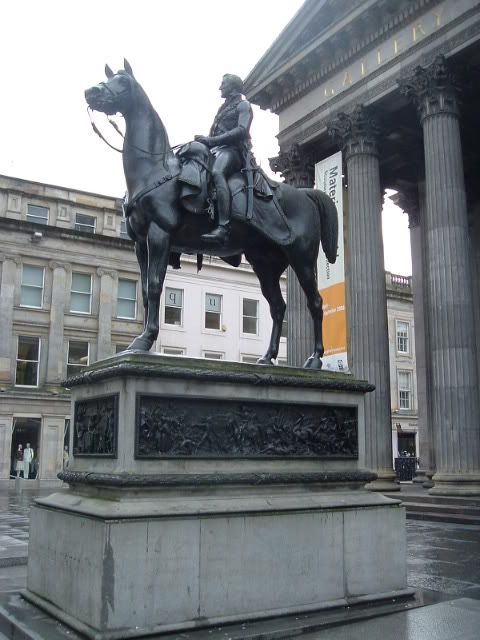
When we got to the station, Gordon showed me which train to catch out to Greenock, which is kind of a suburb for Glasgow. To do touring in the city, I'd have to commute, but, hey, it's a small price to pay for a free place to crash. I even got a double air mattress, which was more comfortable than my plywood bed in Hatfield. In addition, I got to see interesting little sights out of the way of the main population.
This is the James Watt Pub, strategically placed between the Watt College campus and the student halls. I asked what the difference between an English pub and a Scottish one was, but the answer probably isn't fit for publication.
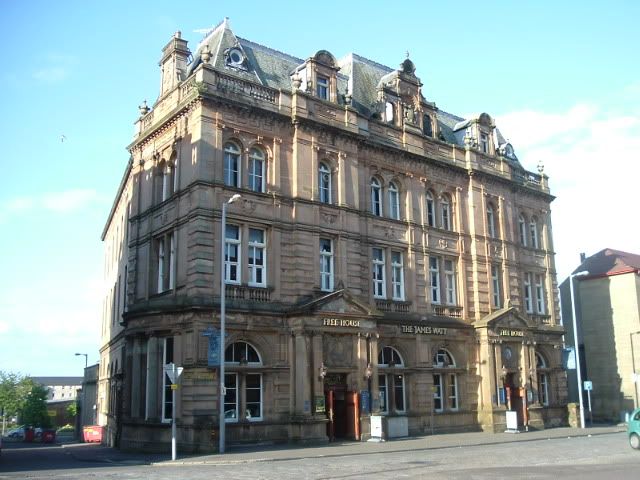
There were lots of simple things to catch my interest. This fountain reminded me of the ones in Zurich. Gordon called me a tourist for taking its picture. He was right to do it.
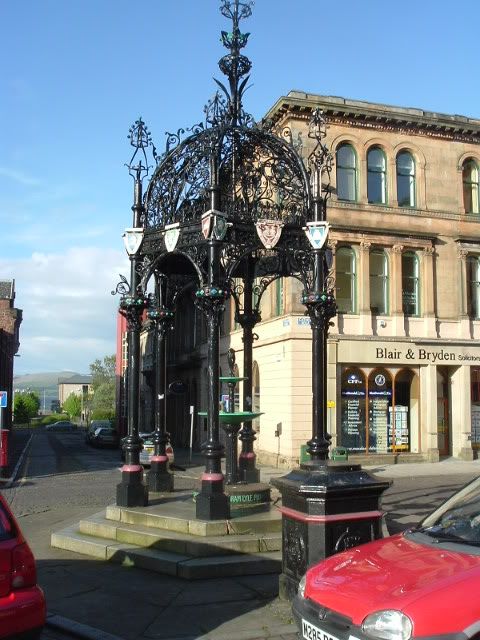
That night for dinner, I experimented with Scottish cuisine by having fried Scotch pie and Iron-Brew. The Scots will deep fry anything, which is fine in my book. I'll probably have to eat salads for a month to make up for a week of Scottish food.
Later on, we hung out at the pub for a while, and they taught me a few Scottish words, such as "chibbed", which means "to be stabbed". For example: Be careful whare ya walk in Glasgow, or ya'r'll get chibbed.
Tuesday: "It's rainy, windy, cold, gray, and bleak. Why would my ancestors ever think of leaving?!"
The next morning I slept fairly late, something that would become an irritating habit during my stay. Scottish weather is conducive to sleeping, what with the rhythmic pattering of early morning rain, gray skies shielding bright sunlight, and a gentle cool that makes you wrap up in blankets like a cocoon. Mm, I'm sleepy just thinking about it.
But, I couldn't sleep all day, and I dragged myself out for a day of touring. Gordon showed me the way to the station, and I got my ticket for a trip into Glasgow. Unlike the typical polite-to-the-point-of-robotics English ticketmaster, the Scottish are pretty easy going and like to joke and talk with patrons. I didn't have a clue what they were saying, but they sure were nice about it.
After getting into Glasgow, I got some directions from the tourist office and then scooted off to see the somewhat famous Provand's Lordship, the oldest building in Glasgow. According to family history, "Provand" is where "Provine" comes from, meaning this was the stomping grounds of my ancestors 400 or so years ago. It's humbling to think. What're my descendents going to think about me in 2406?

I toured the house (which was surprisingly roomy for a 550-year-old building) and then turned around to look at the Glasgow cathedral. It is also known as St. Mungo's, named for the patron saint. There's a rhyme that talks about his deeds, which are shown in the lamppost: "the bird that never flew, the tree that never grew, the bell that never rang, and the fish that never swam." Heh, and I thought the English were cynical. Thinking about it, the Scots may very well be more cynical, but they're much jollier about their pessimism. Whatever the case, they build cool cathedrals.
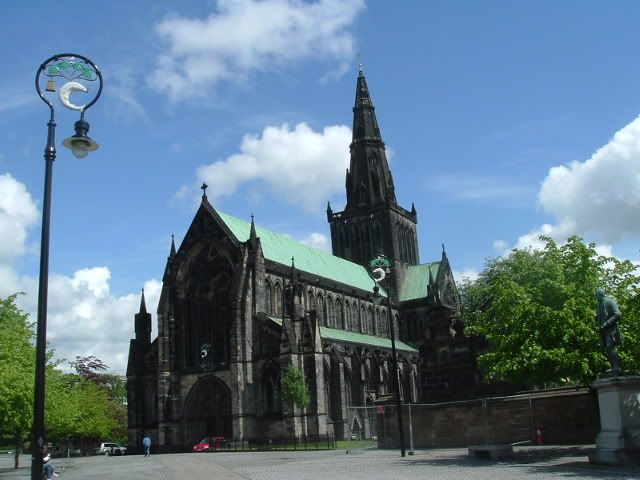
It was exceedingly gothic, which lots of big, scary gargoyles.
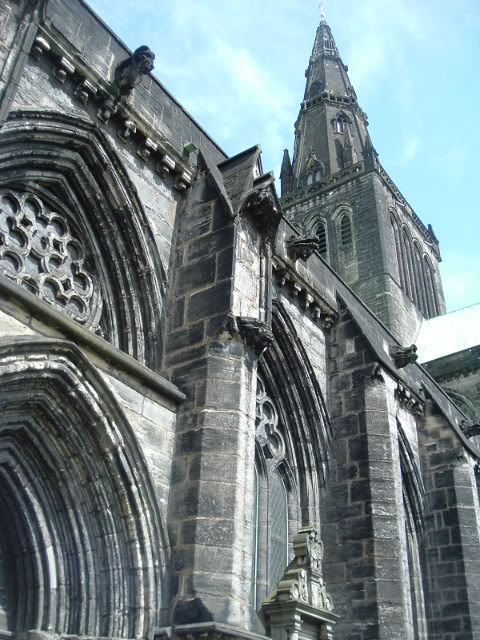
And, of course, it had to be massive and cavernous, but still dark so the Calvinism isn't disturbed. Hardly the gold-plated cathedrals of Italy, but beautiful in its own way.
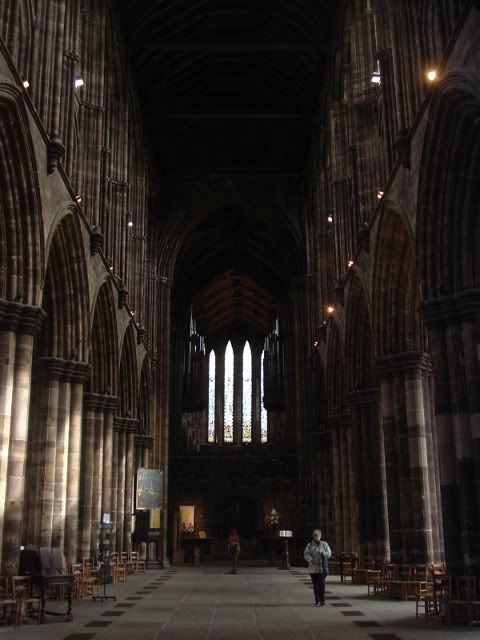
The stained glass was very nice as well. Most of the windows throughout were in honor of different military groups throughout the centuries. Scots definitely take their soldiers seriously, which is refreshing to see in this age of badmouthing troops.
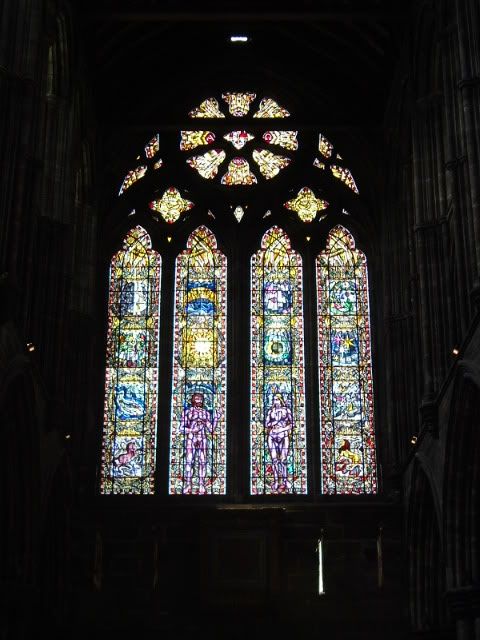
After the cathedral, I checked out a few more statues of famous Scots, such as Livingstone...
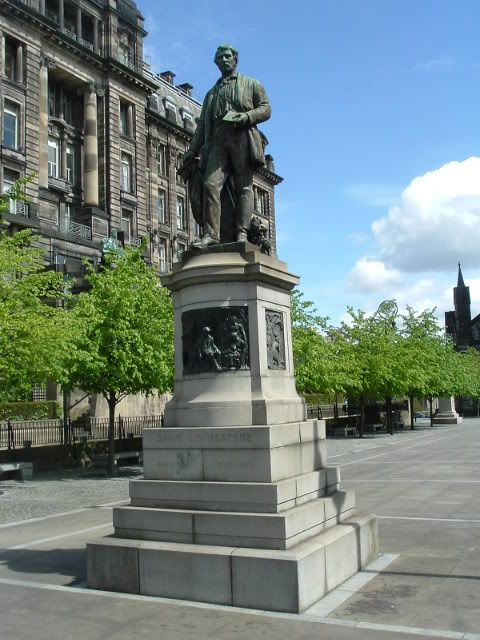
...and then went to the St. Mungo Museum of Religious Life and Art. It was an interesting collection with items from most of the major religions, comparing what various religions thought about birth, death, priests, living, and so on. It did not go into a great deal of depth, but at least I finally figured out what Sikhism is.
After I finished with the museumy stuff, I headed outside toward the massive hill near the cathedral known as the Necropolis. The sun was out, so I decided to take a stroll through this city of the dead.
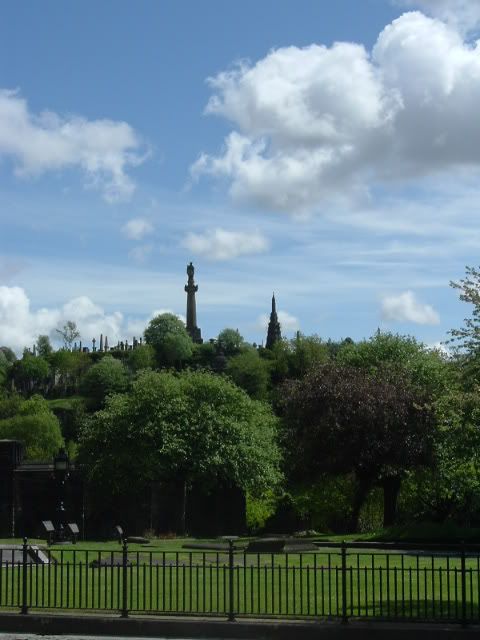
The monument at the top is to John Knox, the guy who pretty much swept Catholicism out of Scotland. Unlike English cemeteries, which are really cramped and eerie, Scottish graveyards are strangely inviting. Maybe it's the big, pretty monuments or just all the green space used as parkland.
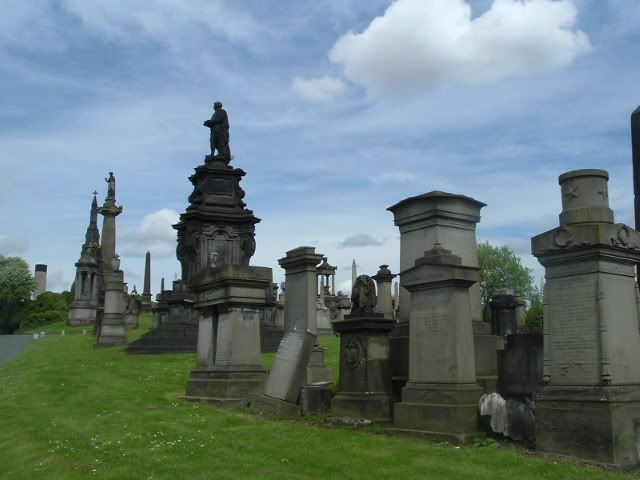
On top of the hill, there are some nice views of the city laying out around. Glasgow is indeed a modern city, with lots of industry and sprawl.
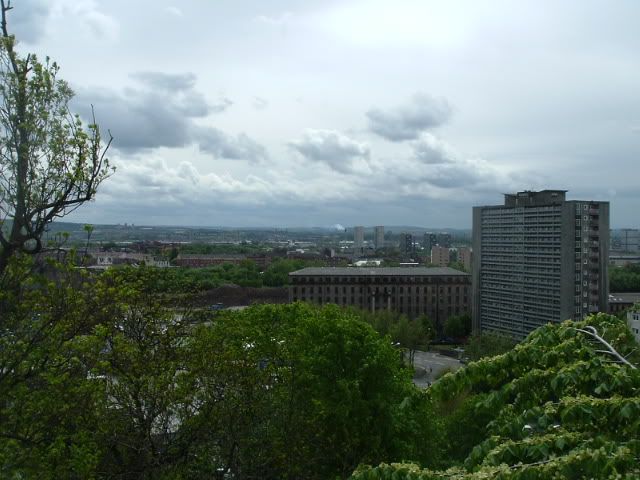
But, it's certainly got its share of pretty views, too.

As I was walking through the park and checking names on monuments, it occurred to me that I was surrounded by people dead for hundreds of years. At first, it got me all philosophical and reflecting on my own life, wondering what a student wandering past my grave might think of me. Steadily, though, it just creeped me out and I decided to move on.
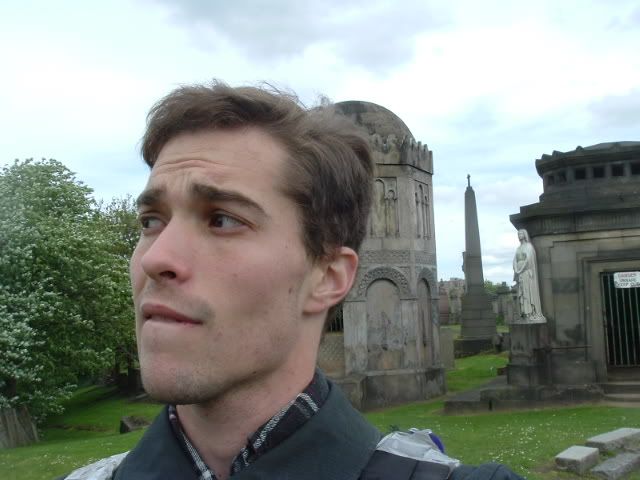
Heading back into the heart of town, I went to the Museum of Modern Art, which had a combination of brilliant pieces, things I would hardly label as art, and a few things that were literally dragged out of a dumpster. As I went through, I wondered how one became an art critic. I think I'd make a pretty good one: I know what I like and why, as well as what I don't. Now just to have legions of mindless followers.
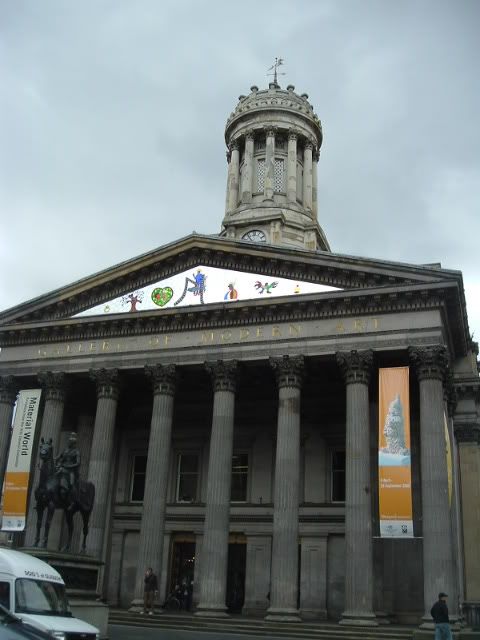
When I was finished with the museum, the Scottish weather had turned on me. Earlier I have whined on and on about the strangeness of English weather, but Scotland proved its weirdness to be ten times greater. Within five minutes, it can be sunny, pouring rain, sunny again, and then raining in a hard mist. My mind is boggled. I made a point to carry my umbrella everywhere, even though most often the sun came out before I had finished extending it. What a country.
Braving the rain for a while, I walked through a few more of the shopping areas and checked out the River Clyde, on which Glasgow was built initially for water supply and then booming with shipbuilding and trading.
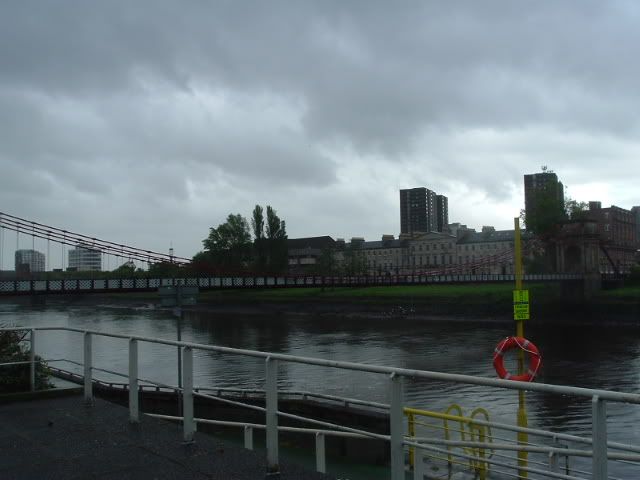
I did a little more exploring, finding a few eccentricities such as a huge comic book shop and that Scottish crosswalks with lights for pedestrians activating at the same time, stopping all traffic, whereas most crosswalks I've seen time pedestrians with parallel traffic. A Scottish girl taking signatures for charity accosted me, but I explained that I was just traveling, which wasn't a help since she was wanting people who had British bank accounts. With business behind us, we chatted for a while, and she highly recommended Edinburgh, which led into me asking questions about Scottish culture and the difference between old-fashioned Edinburgh and metropolitan Glasgow. In all, it was a far more pleasant experience than the psycho lady in Florence who dismissed me as soon as she found out I was American.
Having had my fill of touring adventures for the day, I caught the train back to Gordon's. On the way, I stopped at a chip shop, getting a sample of Scottish cuisine: battered pizza and a battered Mars bar. The Scots really will deep fry anything, and it made my tummy happy. The pizza was incredible: crunchy and chewy at the same time and loaded with heart-stopping calories. But the real thrill was the legendary fried candy bar. I had tasted fried Kit Kat once before (when Chad, John, and I got the frier out one night and things quickly got out of hand), which was great, but Mars bar was infinitely superior. The nougat, chocolate, and caramel had all melted together inside a crispy crust, creating a nebulous mass of pure tasty exhilaration.
During dinner we watched plenty of American television (Scrubs seems ubiquitous internationally) followed by the movie Lord of War. Fried food and violence, mmm, what an evening. But the best part had yet to come.
Thanks to the wonders of technology, Gordon had a system that could make international calls free of charge. I remain in pretty good contact with home via e-mail, but it's always comforting to hear a familiar voice. After searching the depths of my memory for my phone number, we typed it in and pretty soon I heard a confused, "Jeff, is that you?" on the line. Things seemed to be busy and well at home, and my parents were the same old Mom and Dad. My dad gave me a history lecture and a list of things to see in Edinburgh, and my mom was worried I looked too skinny judging from my pictures. Well, a few more battered Mars bars would take care of that, certainly.
Wednesday: Swimming
I overslept again, thanks to the comfort of the Scottish morning. If I ever have a mental breakdown, I guess I could come to Scotland and just sleep it off. It is a pleasant country, but there's too much to do just to lay in bed all day.
Due to my oversleeping and technical difficulties on the train into Glasgow, I didn't get into town till one o'clock. I did have lunch, however (skipping meals isn't allowed any more), which was a steak bake and bacon and cheese turnover purchased at the local supermarket on the way to the train. Mm, the Scottish food tasted so good, but I imagined that I'd have to spend the next month eating salads to clean out my system.
For touring, I went to a place called the Lighthouse, which was an old newspaper building converted into an architectural museum. Part of the guidebook for the museum was in Scots, which many call the national language. I personally found it to be oddly spelled English with bizarre grammar and rambling phrases. They had some nice views of the downtown from the top floor.
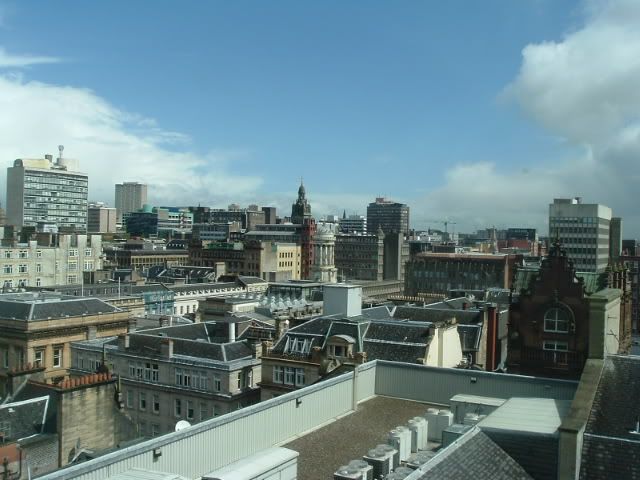
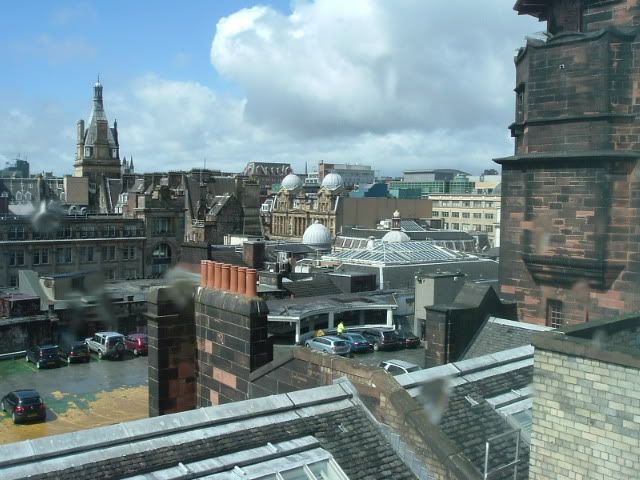
The low, glass-roofed building toward the center was called "Ca D'oro", though it was nothing to the real Ca D'oro in Venice. Tsk, tsk, there's just no matching Venetian coolness, especially if you try to mimic the Bridge of Sighs (...Oxford!).
Just as I was finishing up checking out the things about Art Nouveau, I got a text from Gordon, who was getting off work to go swimming. Swimming in Scotland, I thought, now there'd be an experience. So, I finished off the museum and wandered around to meet Gordon by the subway, checking out some of the city's architecture firsthand.
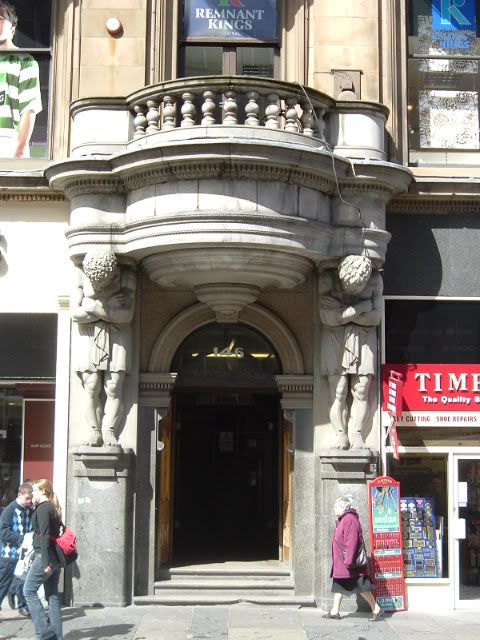
I also got to see a recruitment van for the Scot Guard, who looked pretty cool in their uniforms. All the teenage girls hanging around seemd to think so, too.
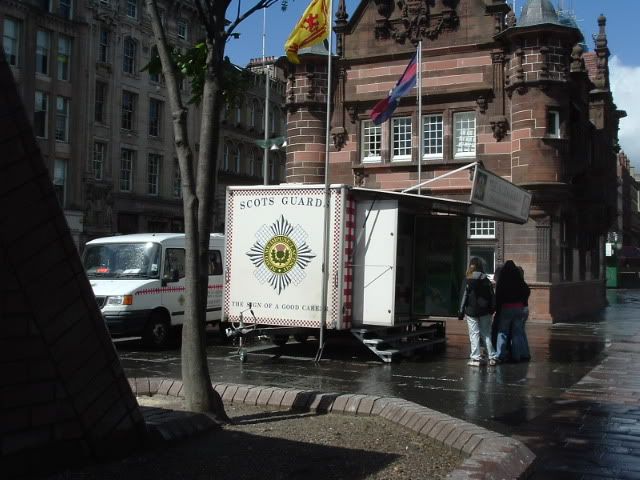
Eventually I met up with Gordon, and we took the train out toward the sea to the town of Gourock, where Gordon did most of his swimming. He said the pool was heated (though the water came from the river, ick). I was a little concerned about the weather, but who wouldn't want to swim on a day like this?
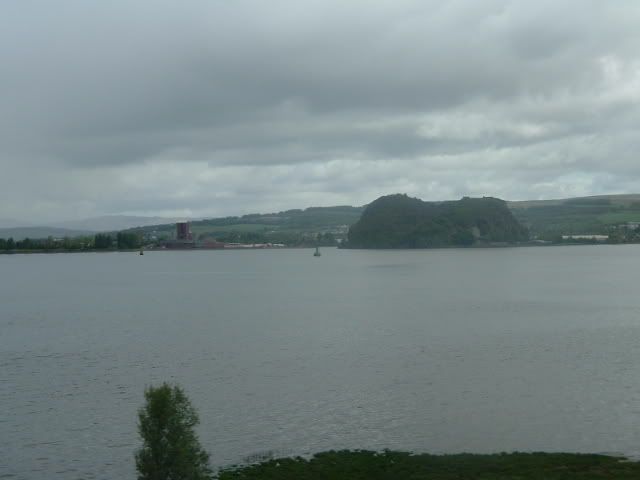
When we got to the pool, the clouds had cleared enough, but the wind was freezing and no amount of promise of swimming health made it fun. If one held close to the heating jets in the pool and ducked under the water, it would be just warm enough not to die of hypothermia. Of course, the jets were the same place cold, fresh water came in, which would be a bit of an unpleasant surprise, to say the least. Gordon, who somehow swam laps regardless, eventually gave in to my whining, and we headed back. Actually, after drying off, getting dressed and putting on three layers to block out the wind, the weather was pretty swell. The sunlight made the nearby beach look inviting, but it was just a deadly trap.

We got back to his place and warmed up, watching more American television as well as a British comedy sketch show called Little Britain, which is apparently famous, despite my Yankish ignorance. We also watched the infamous Baseketball, made by the South Park guys and pretty tame in comparison to today's movie trash. Along with dinner, I tried some Scottish 10p crisps, which were thouroughly disgusting, yet I couldn't stop eating them.
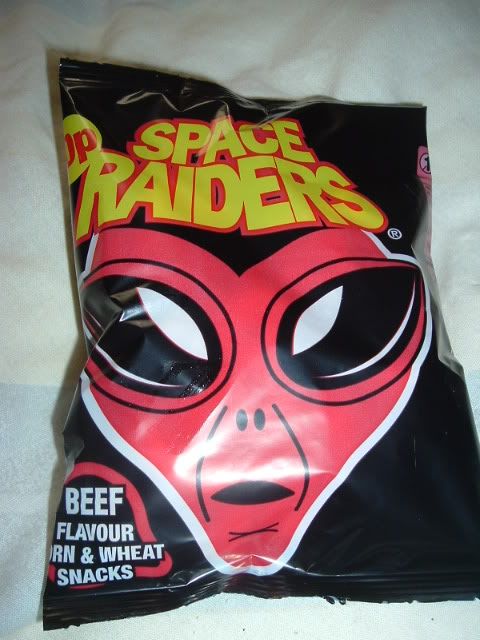
Thursday: "It's pronounced 'edin-burrra'."
I managed to get myself out of bed earlier and catch the train into Glasgow to catch another that would carry me to Edinburgh, Scotland's capital and home of the Edinburgh Castle. The city is laid out on two sides of a valley, which used to be where they dumped all the garbage. The old city is on one side, with the new city on the other, and the valley was cleaned up when they installed the train station. All along the way, I got to check out more Scottish landscape filled with green grass, yellowed grass, hills, crags, and more sheep.
While Glasgow is a mixture of the old and new and going forward as an economic city, Edinburgh is holding onto its history both for tourism and political power. It has plenty of awesome architecture, which is immediately visible after leaving the train station.
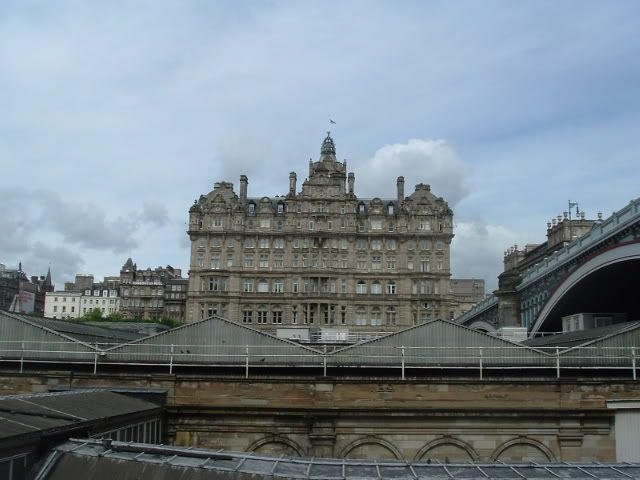
I nabbed a city map from the tourist office and made directly for the castle, where I would spend a good portion of the afternoon. Along the way, I saw many a kilt (and each time I got the urge to point and yell, "Man in kilt!", but I resisted) and pipers. Actually, I was in the city for only about three minutes before bagpipes kicked in. Mm, this was the Scotland I had imagined.
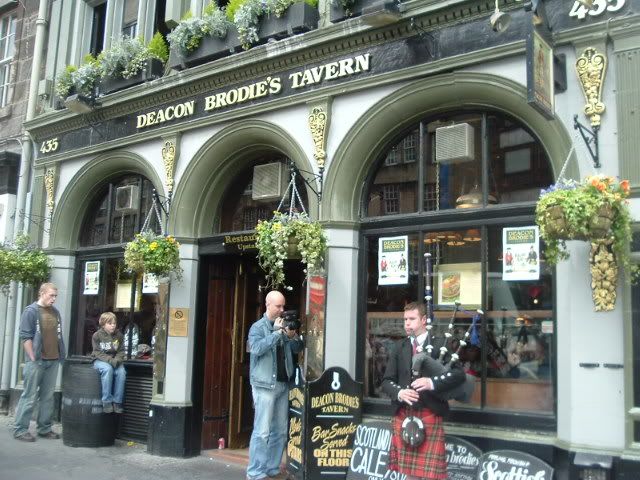
The castle was indeed very awesome. I had not done a proper castle yet in my stay, though the ruins of Canterbury Castle were quite cool. This one was still in use, with guards posted and a timing gun firing at one o'clock, which coincided with my arrival. I pretended that it was a salute to my coming. I pretend a lot.

The gate into the castle is guarded by statues of Bruce and Wallace. Once inside, one can see how the castle is still a veritable city, though more geared toward tourism than military. There were lots of museums inside, including the Scottish National War Museum, one about timing devices, Scottish history, one for prisoners of war during the American Rebellion, and history of the castle itself, complete with a model.

There was a museum for dragoons and one for infantry, which were both remarkably cool, even if the life-sized dioramas were a little spooky.
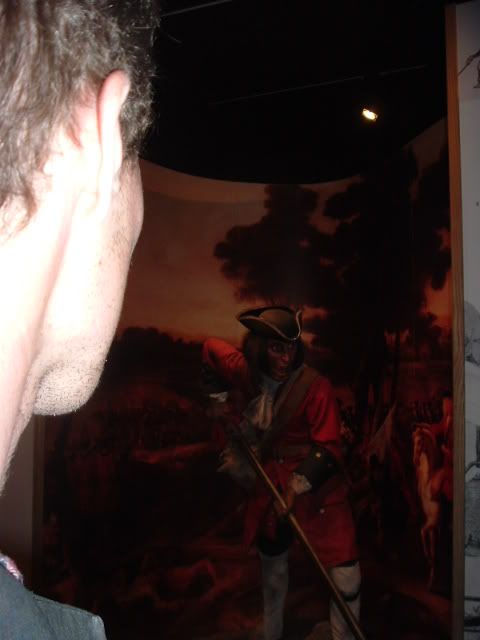
They also had the enormous Mons Meg, a centuries-old siege gun that could fire up to two miles away. Unfortunately (or I guess fortunately for those defending), it proved too heavy to be practical.

At the top of the hill was the WWI memorial, which was an incredible blend of medieval and art deco architecture. From the back, I mistook it as an original tower.
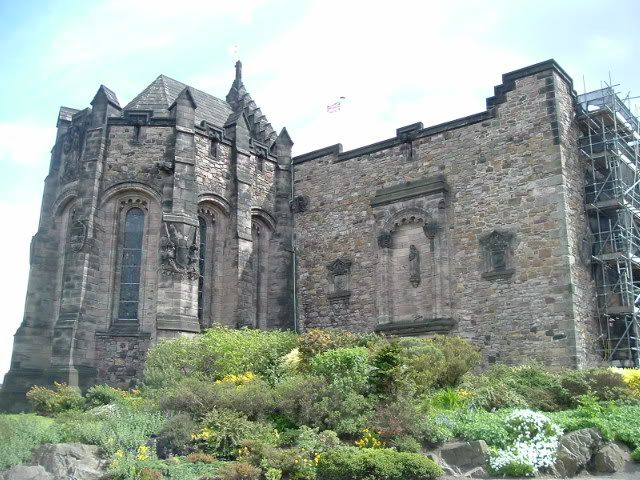
From the front is was more obvious and even cooler. I got to watch the changing of the guard.

Also inside the castle were the Scottish Honours, which are the crown jewels of the old Scottish monarchy. Whereas the crown jewels in the Tower of London are simply displayed with kind of a "by Jove, aren't these delightful?" spirit where one has to go to the gift shop to hear the story of Colonel Blood and his attempt to steal the crown jewels (for which he not only got off scot-free but also got a place at court just for being so cool), the museum for the Honours goes back to Robert the Bruce and tells the tale of Scottish monarchy and the additions to the jewels, building up to the story of how Sir Walter Scott found them after they had been locked away and hidden for years. They build up to finally showing you the jewels, complete with the Stone of Destiny, upon which monarchs have been crowned for centuries.
When I had scrampered through every last corner of the castle, I decided to move on to see the rest of the city. Edinburgh Castle and the old palace are connected by a long, tourist-filled street known as the Royal Mile. It was downhill, so my feet led me that way. I stopped off every so often at a shop that caught my eye and free museums that showed the big musical review known as the Tatoo and how tartans are made.
Back on the streets, I saw a bunch more cool statues, such as Hume, the famous philosopher and Utilitarian.

Further along was Alexander the Great and Buccephalus, along with a war memorial.

There is also the heart-shaped mark of where executions used to take place. It is Scottish custom to spit on it, and, if you can hit the center, it's good luck. I saw quite a few people hit it as well as a few blissfully ignorant tourists walk through it, never knowing what nastiness their feet had just picked up.
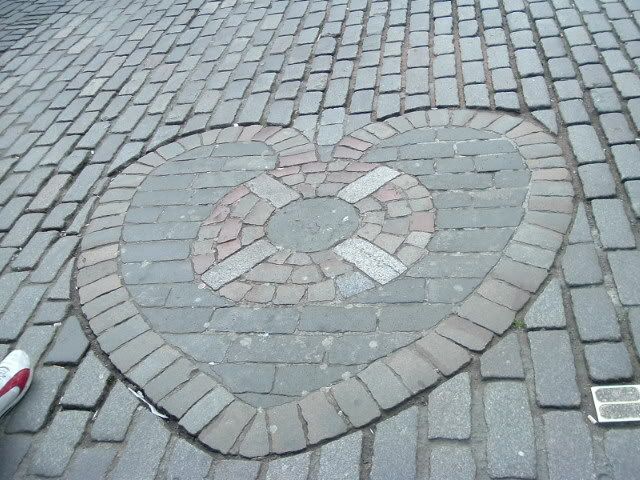
Right next to the heart is St. Giles' Cathedral, which had some of the best stained glass I've seen in a long time.
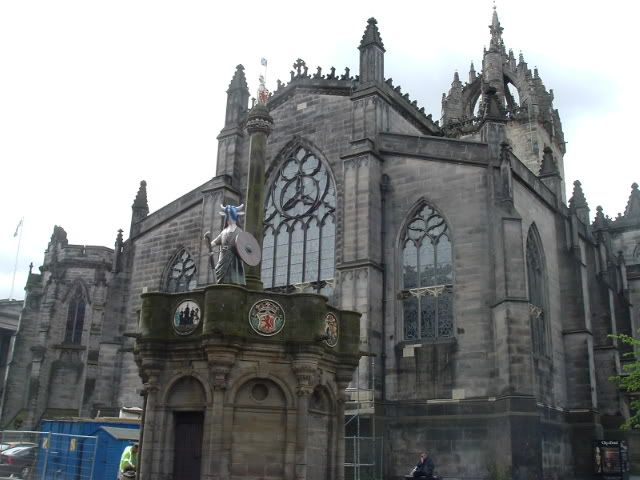
It also had a life-sized statue of John Knox. As you can see, he was a big, huggable bear of a man.

There was also a memorial commemorating anaesthesia, something we often take for granted these days.

Leaving the cathedral, I headed farther down the Royal Mile, checking out all kinds of cool Scottish buildings. Everything was still gray and drab to fit the motif, but that didn't stop it from being nifty, like this tavern.
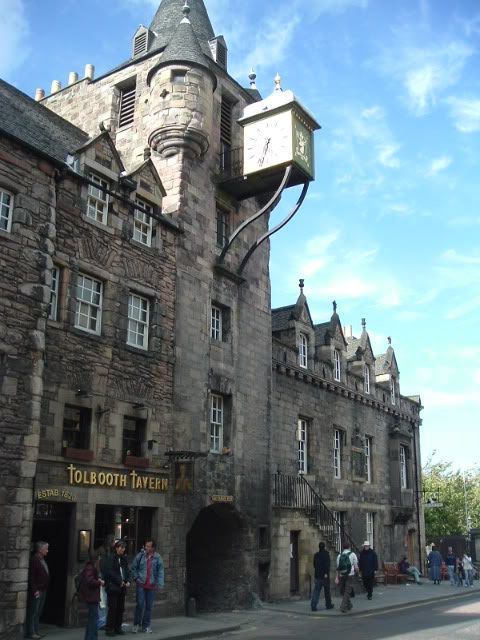
Toward the end of the street is the new Scottish Parliament building. I've long searched my heart to find something positive to say about it, but I can't come up with anything more than saying it looks like it'd be warm (though not dry as the roof apparently leaks). Ugh, such awesome buildings for a whole mile, then this modern structure.
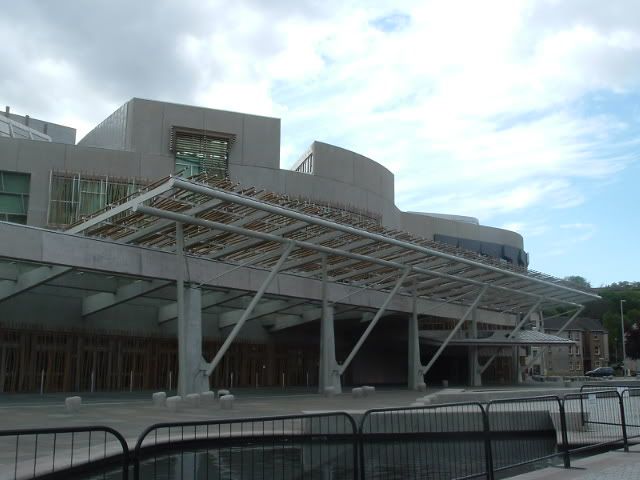
They did have a cool collection of poems about Glasgow along one wall, so I guess that is at least one redeeming feature.
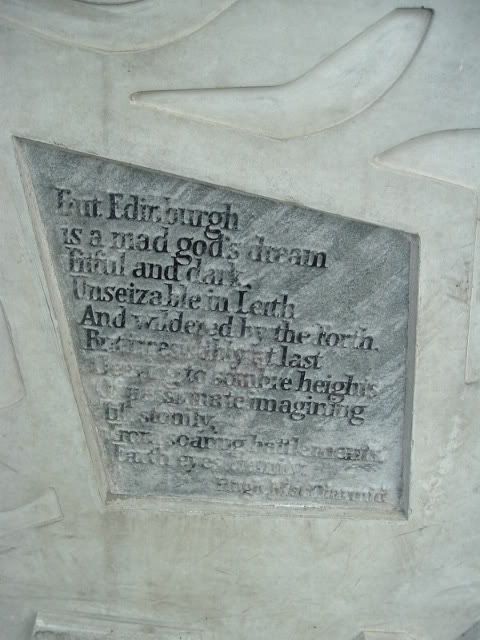
Besides, the towering and amazing Salisbury Crags are right beside it, so one doesn't have to let one's eyes settle too long on the parliament.
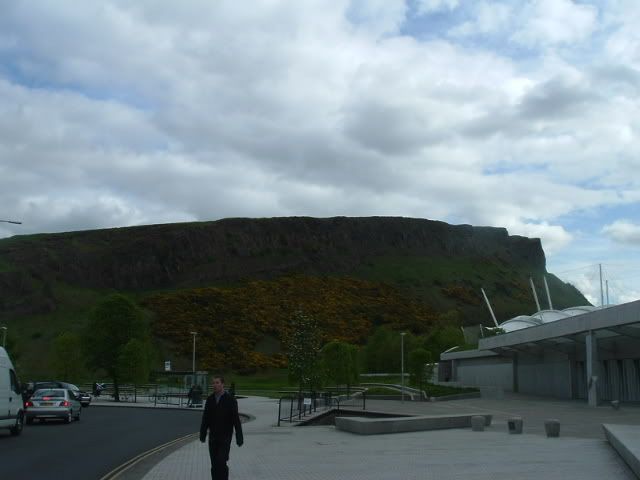
Across the street is the old Palace of Holyroodhouse. It was closed by the time I got there, but pretty nonetheless.
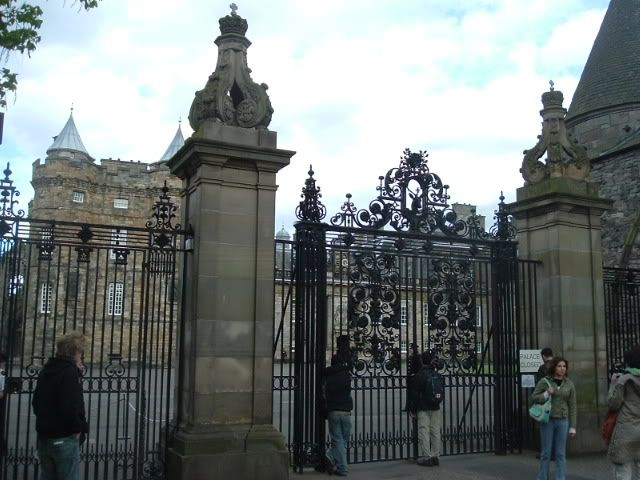
Even the Queen's Gallery was closed, making me wonder what was beyond the nifty doors.

Having run out of Royal Mile to walk, I turned around and headed for the newer part of the city across the valley. Along the way, I passed another strangely inviting Scottish graveyard, but I imagined it would only end up freaking me out again.
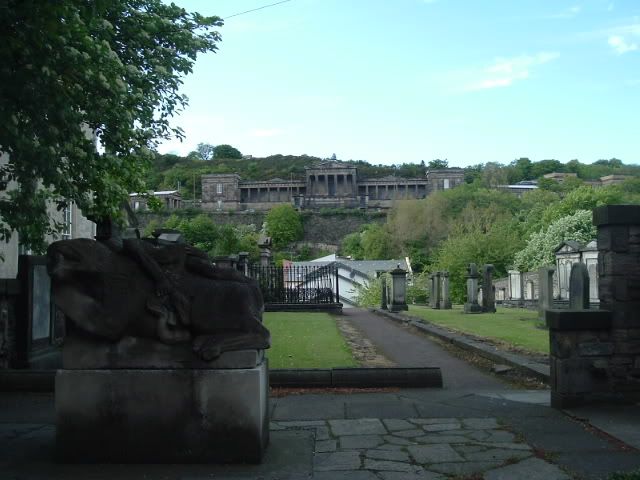
I went around a bend to look out over the city, then hiked up one of the named streets that climb the edge of the Royal Mile. Man, and I thought Lombard Street was steep.
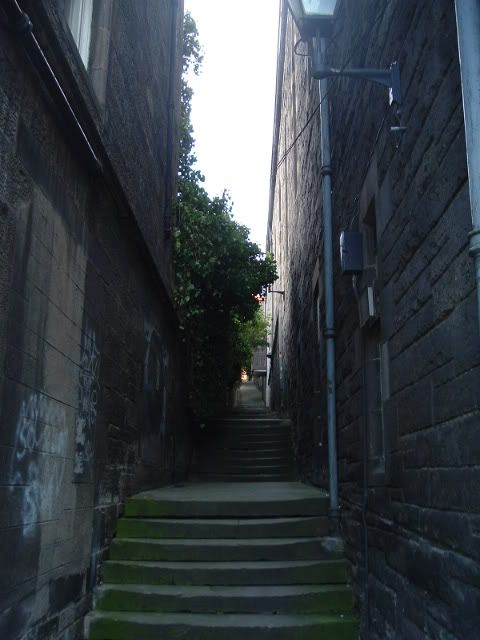
Once I got across to the new city, I was revitalized by sweet, sweet looking buildings and plenty of statues, such as one for Livingstone.
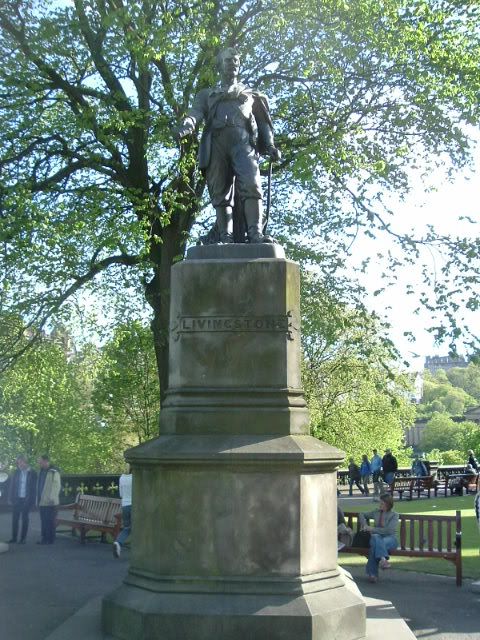
And another for Wellington (which breaks the old custom by raising hooves when he didn't die in battle).
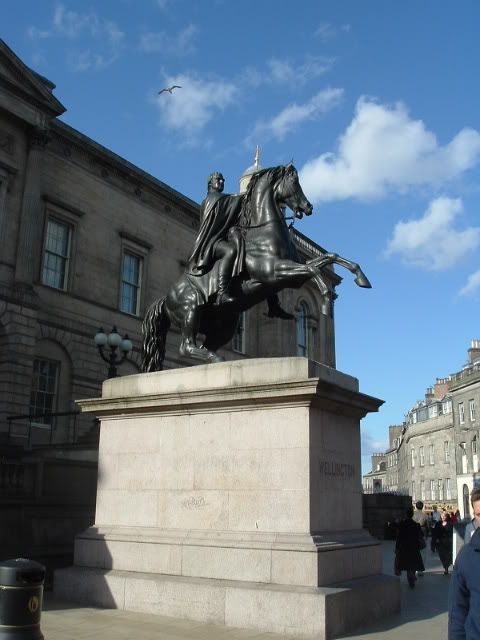
And the massive memorial for Walter Scott, which was like a bleak, huge version of that for Albert.
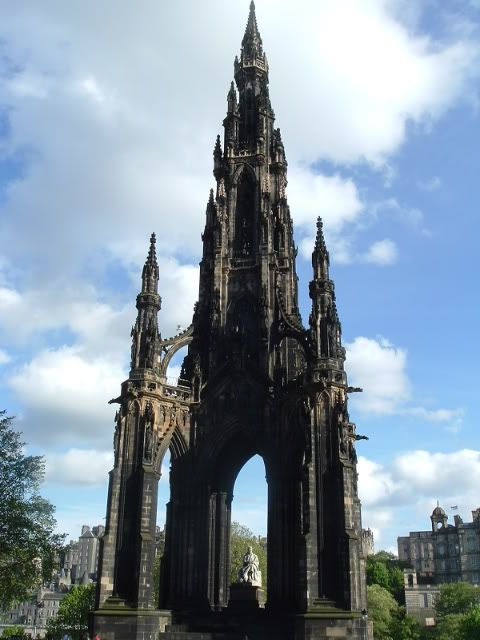
There were also a lot of cow statues around, part of a charity art thing. Some of them were pretty nifty, like this Holstein of the world. They should genetically engineer a real cow like this.
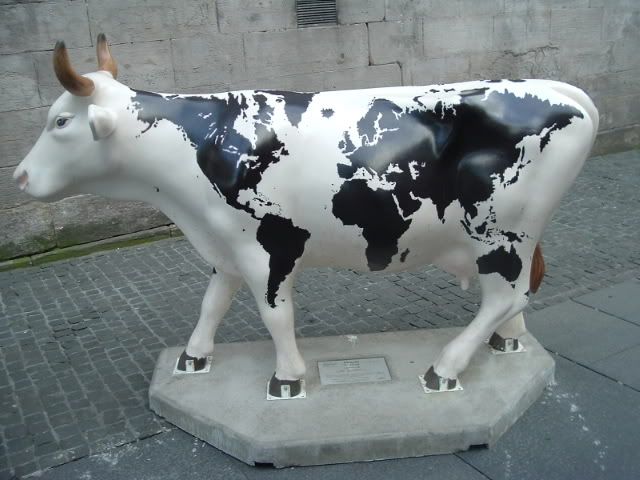
After walking the streets for a while, I headed up to the park atop Calton Hill. The park seemed to be popular with the tourists (there was a gang of French people and a pair of Asian girls all with cameras who came up behind me) as well as locals (people just hanging out and walking their dogs). It was no wonder it was so popular; despite the wind, the sun was shining, the views were great, and bagpipe music floated up from the city below.

The park itself was very pretty, with wide, open, grassy fields and even a few flowers and trees. If I had a frisbee, it would've made for quite a game, overlooking the beginning of the North Sea.
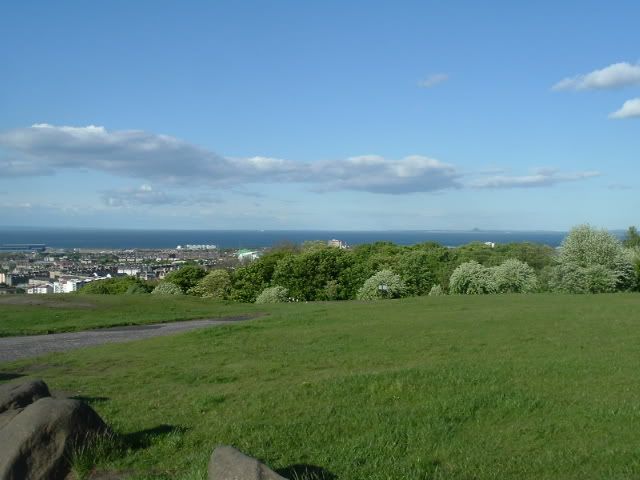
Just beyond the city is the bay, called the Firth of Forth. A firth is the widening of the mouth of the river. "Firth of Forth" is a funny phrase, especially in a Scottish accent.
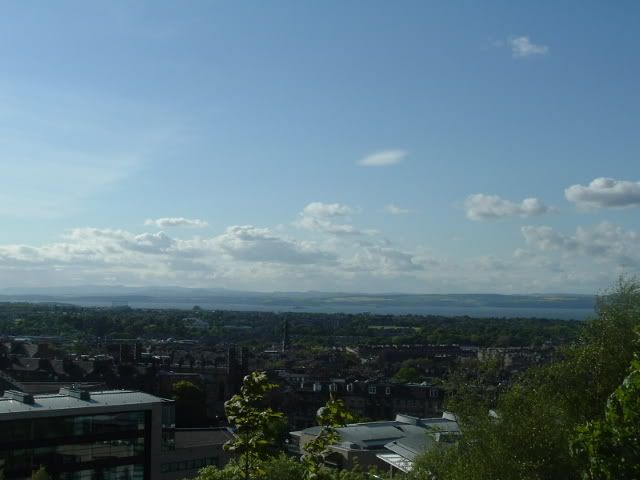
The park also had an observatory, at the top of which was once an orange timing ball, just like in Greenwich. For some reason, they had stopped using it, instead depending on the cannon to set ship's clocks. I can't imagine why. Watching the ball raise half way, all the way, and then drop was one of the most exciting moments of my life. (Ah, there's that Scottish sarcasm coming in.)
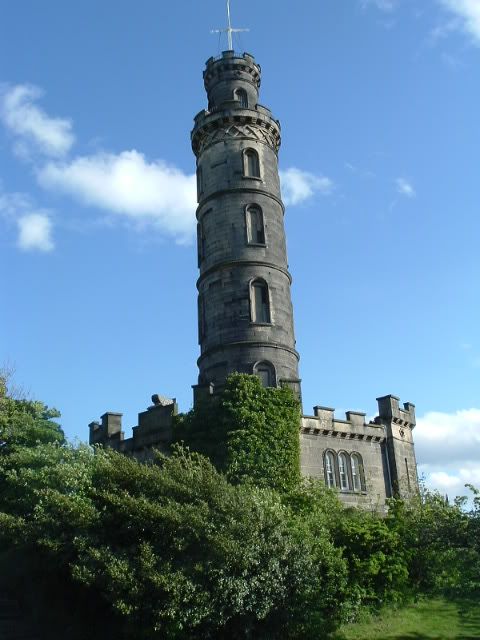
On the other side, you could look across at the cliffs and see the palace below. I couldn't see them, but somewhere a band of pipers was playing, and the music drifted up on the wind. It was so cool, I stood around and listened for a while. (Also, I attempted getting an artsy-type shadow photo with my coat flapping in the wind.)
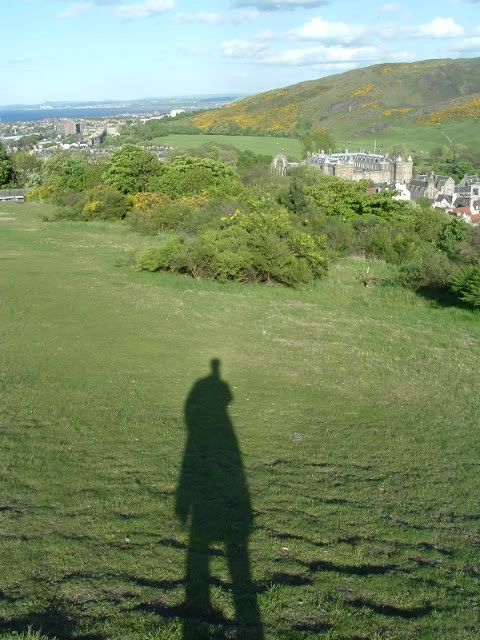
Other than that, I spent the evening chillin', letting the sunlight and bagpipes wash over me. Not quite Palantine Hill, but very relaxing nonetheless.
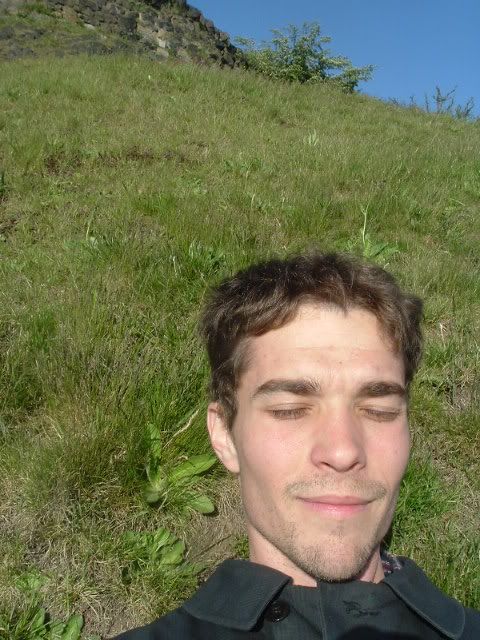
Gradually the sun lowered, and I caught the train back. Scotland the Brave was replaying time and again in my mind, and I suddenly had a strong urge to watch Braveheart. Instead, I settled for a sketch show called The League of Gentlemen before slipping off to sleep and dreaming of kilts.
Friday: "Why did I go to Hatfield again? Oh, right, London."
For my final day in Scotland, I returned to Glasgow (at a reasonable hour, nonetheless) and got a little money from the ATM. Surprisingly, the pounds came out from the Bank of Scotland, which has different bills from the Bank of England. Oh well, as long as it's accepted in England, I'll be fine.
Once at the Glasgow station, I walked up Argyle Street to Kelvingrove park up in the northeast corner of the city. Before my impression of Glasgow had been one of gray, dull metropolitan area, but the area around the University of Glasgow and especially the campus itself proved my ignorance.
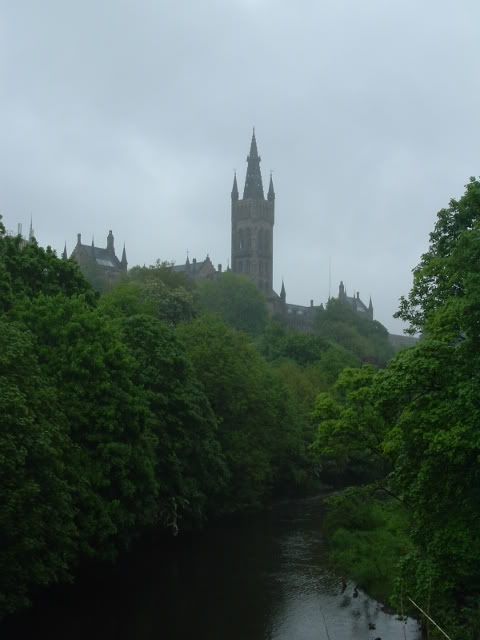
That's the River Kelvin (which came before the Lord Kelvin, namewise) with the bell tower of the university behind it. Wow.
Nearby is one of the most incredible buildings I have ever seen, the Kelvingrove Art Gallery and Museum. The towers, the red and black color scheme... it was just awesome. My heart was crushed, though, as it was closed for renovation for the next month or so. Arg, I guess I'll just have to come back some day.

Instead, I went to the Museum of Transport right nearby. When I first walked in, I came across a row of Rolls Royces, which pretty much set me to drooling. They had awesome cars in the '30s and '40s, even if they did get only twelve miles to the gallon. Eventually, I tore myself away from the cars and went to look at a walk-through model of a 1930s street scene, complete with a cinema (which was playing Peter Pan, so I stayed for a while) and an Underground stop, which had a battery-powered tow car.
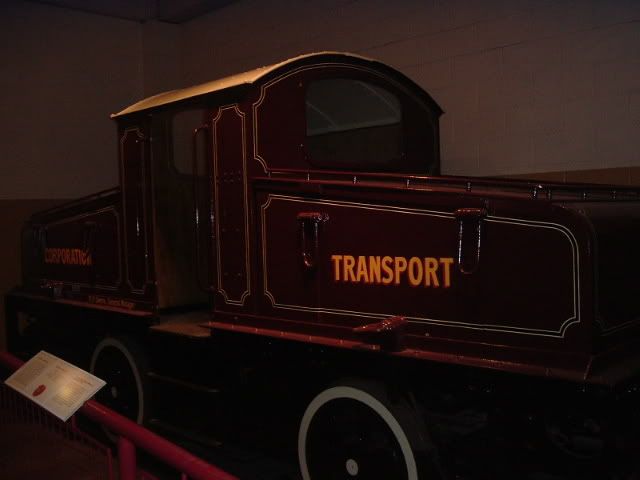
The rest of the museum was pretty much just row after row of awesome vehicles, ranging from 1898 single-person lawn-mower-sized automobile to old doubledeckers to trolleys to a prison van to velocipedes to a couple of trains to a huge, cavernous room filled with model ships and an exhibition about Glasgow shipbuilding. They even had a Ford Anglia.
Despite the Harry Potter refrences to the museum, my attention can only be held for so long by rows of vehicles, and I moved on to the University of Glasgow campus. I've seen quite a few campuses by now, from the spread-out Oklahoma U and OSU to Rice, Cornell, and Stanford to Oxford and Cambridge and beyond, but Glasgow may very well take my vote as my favorite. While there are additional buildings based on departments, the enormous main hall stretches on seemingly forever, like a cathedral of learning.
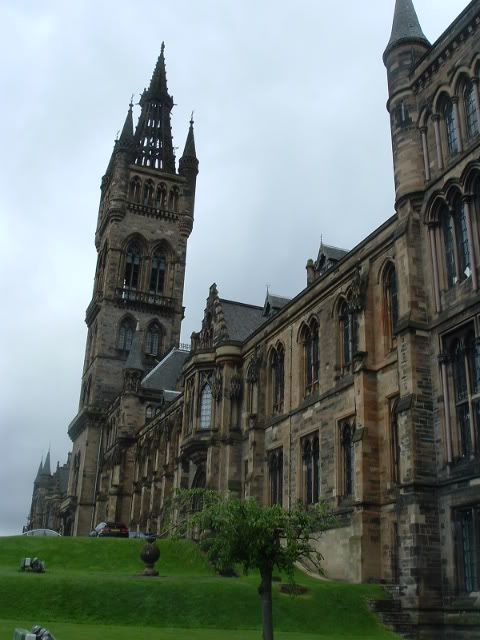
My first stop was the Hunterian Art Gallery, which was exceedingly nice for a university collection. They had lots of Whistlers and even a few Rembrandt etches (though they weren't as impressive since I had seen the real thing in Amsterdam only a few weeks ago). The building itself was cool, with a door leading to nowhere hanging on the left.
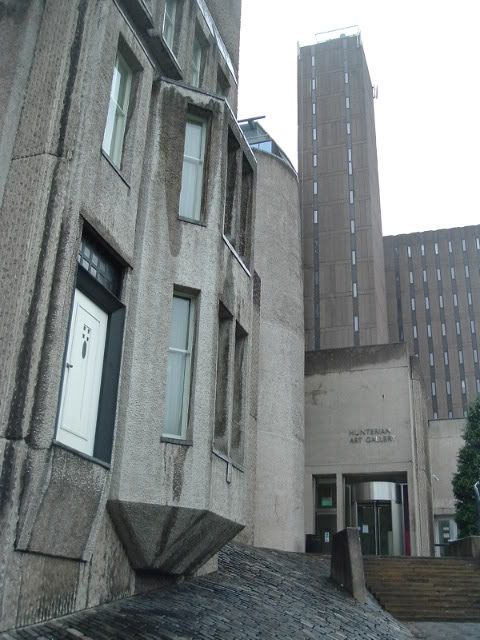
From there I went back to the main building to the Hunterian Museum, of which I had only heard a little and didn't quite know what to expect. When the doors to the elevator opened and I saw a room with a triceratops skull, Roman centurian armor, and cases of Pacific islander weaponry laid out before me, a goofy grin spread over my face and I knew I was where I needed to be. The main room had all these interesting tidbits and more, making it like walking through an attic of cool, old stuff in some professor's house. (Odds are, that's probably where it started.) Afterward I went across the hall to an exhibit about anatomy where they had a furry tongue in a bottle (ick), various bodyparts, and a game where you described your lifestyle and it calculated how long you'd live (it said I'd have a stroke at 67 and then live to over 100; I always thought my heart'd give out first). Then I went to the Kelvin exhibit, which celebrated Kelvin as pretty much the greatest scientist to have ever lived. He was certainly cool and had his fingers in all of the nineteenth century's scientific pies, with plenty of patents and papers. Best of all, they had all kinds of displays to fiddle with, making a glass wobble with soundwaves, feel the temperature change in electrical currents, and a hand-generator for electric lights.
I finished up playing with the equipment just as the lady was shutting up the museum, so I scooted out with her locking the door behind me. (Like father, like son, I suppose, eh, Dad?) I went out a different route (pronounced "root" here), gaping at the awesome staircases and enormous lecture halls where I honestly wouldn't mind taking an exam. After resisting the urge to sneak around, I headed back into Kelvingrove park to check out some more statues, like this of Kelvin.

And this one of Lister, the guy who worked with a lot of anesthetics and had Listerine named after him.
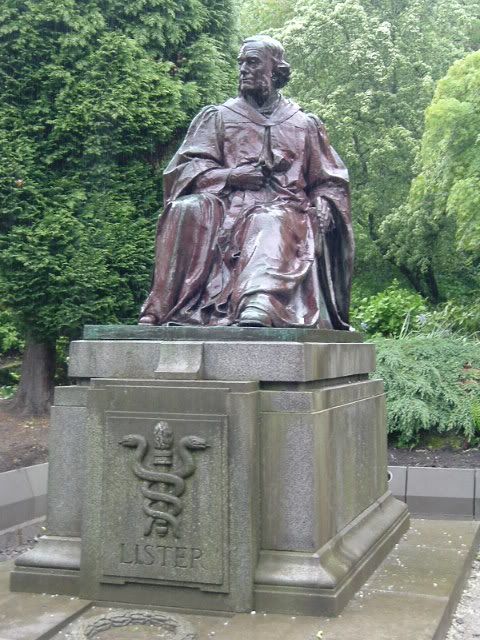
Checking my map, I figured it was about time to head back and made for Argyle Street again. On the way through the park, I looked back to see Kelvingrove again. Man, that is one sweet building. I want one.
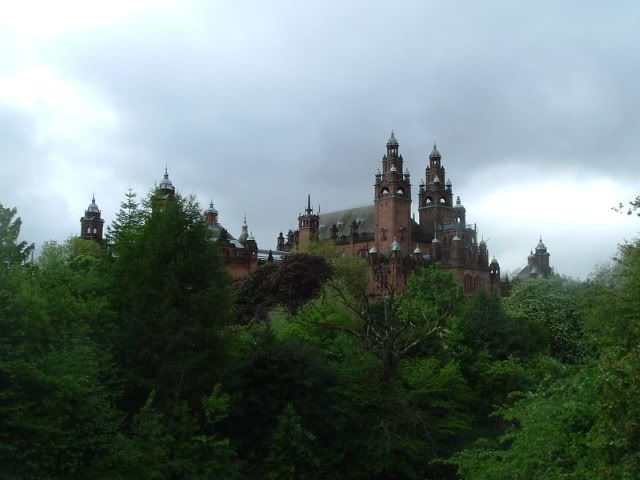
After a quick trainride back, we took a trip to the grocery store so I could try that most terrifying of Scottish delicacies: haggis. If you don't know what's in it, you probably don't want to. Basically, it's the head cheese of the mutton world. Gordon prepared it along with some potatoes and turnip. I held it on my fork for a while, afraid to put the brown, chunky stuff in my mouth. Finally, I got up the nerve and took a bite.
At first, it was downright terrible. I stuck to the potatoes, but the spices in the haggis grew on me, and I ate more and more of it as I went. By the end, I was gobbling it down. Maybe it's an acquired taste, and I certainly acquired it. Mmm, haggis gets a thumbs up.
For dessert, I tasted tablet, which is a relative of fudge and made of the same stuff, just cooked differently. Even if it wasn't deep fried, I liked it plenty. So I filled my belly with Scottish foods, watched Batman Begins with the others, and went to bed, feeling I had done just about all I could do in this Scottish expedition.
Saturday: Southward Again
The next morning I got up and took the train one last time into Glasgow. I had a few minutes to walk around before settling in at the bus station to wait for the bus. It wasn't long, and I was soon on my way in a bus that smelled roughly of aged armpit. For some reason, the driver never turned off the heat, which made it quite a toasty journey. At first, I was miserable, then I realized it was the first time I'd been warm in weeks, which made me revel in it.
All the way back I read The Portable Door, which was far lighter than The Life of Pi and had plenty of clever jokes and references to keep me entertained. I also took long breaks staring out the window at the passing English landscape. I may whine about the weather all the time, but it really is a pretty country. And, in an effort to welcome me back to the weirdness of England, there were a pair of tiny ponies at the rest stop doors with their handlers subtly asking for charity (so subtly that, at first, I thought they just had ponies for no reason). Still, weirded out.
I got back to London in time to grab a sandwich from Subway and catch the last bus back to Hatfield. As an example of how small the world's gotten, I bumped into Michelle the Dutch girl waiting for the bus as well, as she had spent the day in London with her mother. We chatted on the way back, me sharing my pictures and she sharing some Dutch caramel waffles. After all this tablet and caramel, my dentist is going to be horrified when I get back home.
So I returned to Hatfield as the sun was low, and my adventures in Scotland had come to an end. It was good fun, and I think I may've had a little bit of Scottish rub off on me.

Back to Jeff's
Weblog







































































